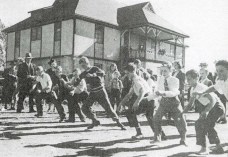 A Bit Of Our History
A Bit Of Our History
The village of Brussels was originally named Ainleyville after William Ainley who first settled in the area. The name was changed to Brussels after the name of the Great Western Railway station at the edge of town when the community was officially incorporated on Dec. 24, 1873. On a walk through the village it is easy to turn ones imagination back to late Victorian times when farm villages dotted south-western Ontario. Brussels has managed to retain much of the architectural flavour of the period just before and after 1900.
A short walk around town, beginning with the library at the corner of Turnberry and Mill Streets reveals its past. The library was built in 1910 with a grant from the Carnegie Foundation and is in a style similar to the hundreds of other Carnegie Libraries that are scattered across North America. The interior has the original oak paneling and huge oak library tables that were a common feature of libraries and reading rooms of the period.
Walking north you cross the Maitland River you come to Dunedin Street (formerly William Street). A short detour to the left will bring you to a grey limestone home that was the first Presbyterian Manse built in 1869. The material is reputed to have come from the bed of the river across the road from the house.
Turning right at the corner of Turnberry and Dunedin takes you past a small board and batten home on the right and Victorian country-cottage style home on the left. As you walk along the street you find yourself between two of the most imposing buildings in the village.
Melville Presbyterian Church was established in 1857 and is the third church of that name in the village, the second on this site. The current building was constructed in 1914 and has a seating capacity of 650 including a balcony. Although the building is rectangular the interior layout of the nave is on the bias, with the pulpit in the corner. Opposite the church stands Dunedin House, one of the finest homes in south-western Ontario. It was built in 1887 by Dr. W. J. R. Holmes as a replica of Dunedin Castle in Scotland. It was constructed with a two-room dispensary at the front and served three different doctors until 1956. The house is an excellent example of Queen Anne architecture and the oak paneling and stained glass decoration are all original. The remains of a formal garden are visible on the west side and huge beds of lilies make a spectacular show at the right time of year.
As you walk along the street you pass two beautiful homes on the right until at the first cross street you find another Queen Anne style home, this time in red brick. This house was built in the early 1900s. On the other side of the street is a white frame house with a wrap-around porch and the gingerbread decoration that is representative of Ontario country homes of the Victorian era.
Turning right onto Albert Street will soon take you to the Brussels Conservation Area, which has a small playground and picnic shelter. At the other side of the park you will come to the millpond and dam. A walk across the dam leaves you beside the old Logan Mill. This was originally a three-story structure which, was rebuilt in its present form after a fire in 1911. It operated until 1967 when it was closed because its aging equipment and small size made it unprofitable.
Turn right along Sports Dr. (formerly James Street) until you reach King Street where the Brussels United Church Stands. The building was built in 1877 as a Methodist Church.
In 1924 the building was badly damaged by fire and was rebuilt in its present form. The majority of the renovations were to the interior and the outside fabric still looks much as it did when first constructed. In 1925 the congregation went into union and became part of the United Church of Canada.
Directly west of the church is a red brick house built as the parsonage in 1900. It replaced a small brick cottage that had originally served that purpose.
Continuing west you cross Ainley Street (formerly John Street) and are soon out on Turnberry Street exactly one block south of your starting point. The downtown of Brussels displays an unusually consistent architectural style. Many of the buildings were constructed during a flurry of building activity in the late 1800s and display the Eastlake style that was in vogue at the time.
This consistency results partially from the fact that the period was one of considerable prosperity for the village. Unfortunately it also results from the enemy of Victorian business districts - fire.
Between 1860 and 1875 the entire business section was levelled three times. There was a further disastrous fire in 1905. Each time the town re-built saving what it could.
One exception to the sober and somewhat austere building fronts can be seen on the southeast corner of King and Turnberry Streets. The former 5c to $1.00 store displays the usual staid Eastlake upper stories but the exuberant Gothic of the ground floor front gives the impression that the original owner liked a little flair.
There are many other buildings of interest in this village of 1000 and a walk through its tree-lined streets provides a glimpse of small town life as it used to be. Visitors are welcome to enjoy the ambience but ask you to remembered that the houses are private homes and should be admired from the sidewalks not the front lawns.
|
|
|





